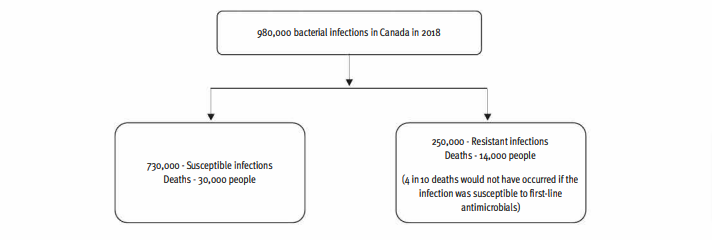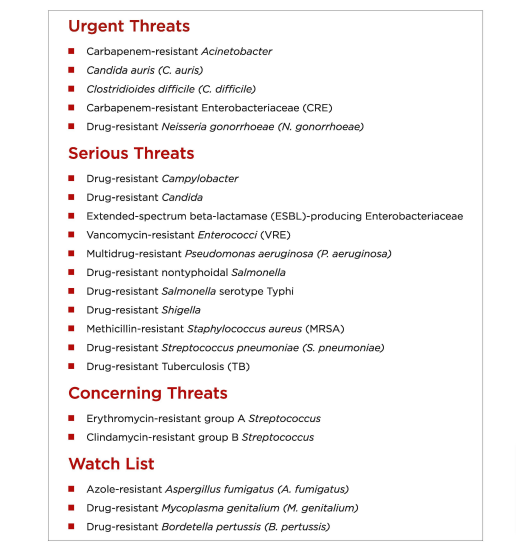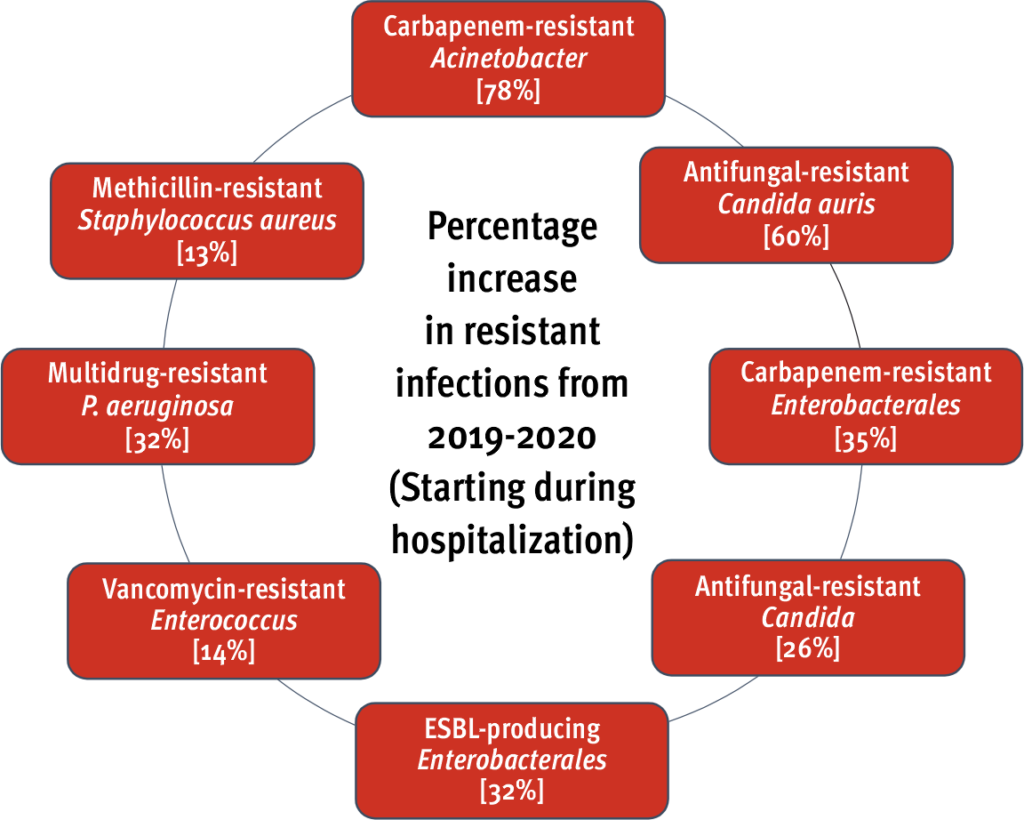AMR’s Burden
AMR’s Global burden
An article by Antibiotics Resistance Collaborators estimated 4.95 million deaths associated with bacterial AMR in 2019, including 1.27 million deaths attributable to bacterial AMR.

Figure 1: All-age rate of deaths attributable to and associated with bacterial antimicrobial resistance by Global
Burden of Disease (GBD) region, 2019
At the regional level, the all-age death rate attributable to resistance was highest in western sub-Saharan Africa at 27.3 deaths per 100,000 and lowest in Australasia at 6.5 deaths per100, 000 as shown in Figure 1.3

Figure 2: Global deaths (counts) attributable to and associated with bacterial antimicrobial resistance by pathogen, 2019
As shown in Figure 2, Escherichia coli(E. coli) was responsible for majority of deaths associated with AMR followed by Staphylococcus aureus (S. aureus}, Klebsiella pneumoniae (K. pneumoniae}, Streptococcus pneumoniae (S. pneumoniae}, A. baumanii, and P. aeruginosa in 2019.3 Each of these pathogens were responsible for more than 250,000 deaths associated with AMR and together they were responsible for 929,000 deaths attributable to AMR and 3.57 of 4.95 million deaths associated with AMR globally in 2019.3

Figure 3: Bacterial infections and resulting deaths in Canada in 2018
As per the report titled “WHEN ANTIBIOTICS FAIL The Expert Panel on the Potential Socio-Economic Impacts of Antimicrobial Resistance in Canada”, the burden of bacterial infections and resulting deaths in 2018 is given in Figure 3.13

Figure 4: Trend summary of different infections, antimicrobial use in humans and animals as well as impactof COVID-19
on antimicrobial use
The 2021 Canadian Antimicrobial Resistance Surveillance System (CARSS) report provides a trend summary of different infections, antimicrobial use in humans and animals as well as impact of COVID-19 on antimicrobial use as shown in Figure 4.14

Figure 5: gives the drug resistance pattern in WHO priority pathogens against selected antibiotics in Canada.15
United States
CDC’s Antibiotic Resistance Threats in the United States, 2019 report states that more than 2.8 million antibiotic-resistant infections occur each year and >35,000 people die as a result.16 As per the report, the below mentioned fungi and bacteria feature in different categories (Figure 6).16

Figure 6: Bacteria and fungi Listed in different categories in the 2019 AR Threats Report
The CDC COVID-19: U.S. Impact on Antimicrobial Resistance, Special Report 2022 stated that was a significant increase in the use of antibiotics with the advent ofSARS-CoV-2 pandemic in 2020.17 As a result, there was an increase in healthcare associated, antimicrobial-resistant infections in U.S. hospitals.17 CDC identified significant increase in infections caused by carbapenem-resistant Acinetobacter, extended-spectrum beta-lactamase producing Enterobactera/es, vancomycin-resistant Enterococcus, and drug-resistant Candida as shown in Figure 9.17 Hospital-onset resistant infections and deaths both increased at least15% during the first year of the pandemic.17

Figure 7: Percentage increase in resistant infections by different pathogens, 2019 – 2020
Reference
- Liar C, Bjerrum L. Antimicrobial resistance: risk associated with antibiotic overuse and initiatives to reduce the problem. Ther Adv Drug Saf. 2014;5(6):229-241. doi:10.1177/2042098614554919.
- Ghosh S, Bornman C, Zafer MM. Antimicrobial Resistance Threats in the emerging COVID-19 pandemic: Where do we stand?. J Infect Public Health. 2021;(5):555 -560. doi:10.1016/j.jiph.2021.02.011.
- Antimicrobial Resistance Collaborators. Global burden of bacterial antimicrobial resistance in 2019: a systematic analysis. Lancet. 2022;399(10325):629-655. doi:10.1016/So140-6736(21)02724-o.
- Pokharel S, Shrestha P, Adhikari B. Antimicrobial use in food animals and human health: time to implement ‘One Health’ approach. Antimicrob Resist Infect Control. 2020;9(1):181. Published 2020 Nov 7. doi:10.1186/s13756-020-00847-x.
- Ghose C, Euler CW. Gram-Negative Bacterial Lysins. Antibiotics (Basel). 2020;9(2):74. Published 2020 Feb 11. doi:10.3390/antibiotics9020074.
- Singh S, Charani E, Devi S, et al. A road-map for addressing antimicrobial resistance in low- and middle- income countries: lessons learnt from the public private participation and co-designed antimicrobial stewardship programme in the State of Kerala, India. Antimicrob Resist Infect Control. 2021;10(1):32. Published 2021 Feb 11. doi:10.1186/s13756-020-00873-9.
- Antimicrobial Resistance, Fueled by the COVID-19 Pandemic. Policy Brief November 2021. https://iris.paho.org/handle/10665.2/55864. Last accessed 16th July 2022.
- Hong HW, Kim YD, Jang J, Kim MS, Song M, Myung H. Combination Efect of Engineered Endolysin EC340 With Antibiotics. Front Microbial. 2022;13:821936. Published 2022 Feb 15. doi:10.3389/fmicb.2022.821936.
- Cerceo E, Deitelzweig SB, Sherman BM, Amin AN. Multidrug-Resistant Gram-Negative Bacterial Infections in the Hospital Setting: Overview, Implications for Clinical Practice, and Emerging Treatment Options. Microb Drug Resist. 2016;22(5):412-431. doi:10.1089 /mdr.2015.0220.
- Paterson IK, Hoyle A, Ochoa G, Baker-Austin C, Taylor NG. Optimising Antibiotic Usage to Treat Bacterial Infections. Sci Rep. 2016;6:37853. Published 2016 Nov 28. doi:10.1038/srep37853.
- Bassetti M, Garau J. Current and future perspectives in the treatment of multidrug-resistant Gram-negative infections. J Antimicrob Chemother. 2021;76(Suppl 4) :iv23-iv37. doi:10.1093/jac/dkab352.
- Gutierrez D, Briers Y. Lysins breaking down the walls of Gram-negative bacteria, no longer a no-go. Curr Opin Biotechnol. 2021;68:15-22. doi: 10.1016/j.copbio. 2020.08.014.
- WHEN ANTIBIOTICS FAIL The Expert Panel on the Potential Socio-Economic Impacts of Antimicrobial Resistance in Canada. https://cca-reports.ca/wp-content/ uploads/2018/10/When-Antibiotics-Fail-1.pdf. Last accessed 19th July 2022.
- Canadian Antimicrobial Resistance Surveillance System Report 2021. https://www.canada.ca/content/dam/phac-aspc/documents/ services/publications/drugs-health-products/canadian-antimicrobial-resistance-surveillance-system·report-2021/canadian-antimicrobial-resistance-surveillance-system-report·2021.pdf. Last accessed 19th July 2022.
- Kumar M, Sarma DK, Shubham S, et al. Futuristic Non-antibiotic Therapies to Combat Antibiotic Resistance: A Review. Front Microbial. 2021;12:609459. Published 2021 Jan 26. doi:10.3389/fmicb.2021.609459.
- ANTIBIOTIC RESISTANCE THREATS IN THE UNITED STATES 2019. https://www.cdc.gov/drugresistance/pdf/threats-report/2019-ar-threatsreport-508.pdf. Last accessed 20th July 2022.
- The CDC COVID-19: U.S. Impact on Antimicrobial Resistance, Special Report 2022. https://www.cdc.gov/drugresistance/pdf/covid19- impact-report-5o8.pdf. Last accessed 2o’h July 2022.
